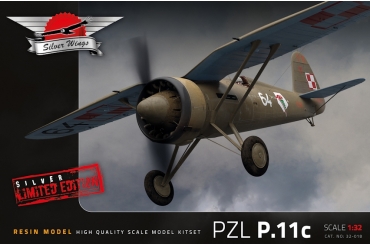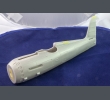PZL P.11c
-
 Box
Box
-

-

-

-

- Cat. No.:
- 31-018
- Material:
- resin
- Scale:
- 1:32
- Period:
- 1931-1939
- Marking options:
- 4 (Polish Air Force)
- Number of parts:
- 142 x resin, 82 x pe, 4 x gun metal gun barrels, film
- Length & wingspan:
- 236 x 335 (mm)
- Additional features:
- main elements iron reinforced, A4 poster, sticker, discs including photos and original manual
- Price:
-
History
The history of the PZL (Panstwowe Zaklady Lotnicze) P 11 started in 1929. Zygmunt Pulawski, the designer at PZL designed an all metal covered monoplane fighter, when the rest of the world was using biplanes. The design is most recognizable by its gull wing shape, which afforded the pilot a better forward view. After designing the P7. the airframe progressed with further variants featuring larger engines, leading eventually to the P 11c. The final version of the P 11c had a new refined fuselage with the engine lowered to give the pilot a better view. The first P 11c's had 600 hp engine ,the later and final ones had a 650 hp engine.
Although it was an advanced design compared to its biplane contemporaries like the He51, Gloster Gauntlet and I-15 when it entered service, by the time war broke out a few years later, it was already outclassed by designs like the Bf109 and Spitfire. However, the PZL 11 handled well, carried similar armament to its peers and was an agile gunnery platform.
While most famous in Poland, it was also used by Romania and even license built with a Romanian engine. Operationally, the PZL 11 was on the front lines in the Polish Air Force when World War II started in September 1939. The PZL 11c has the distinction of scoring the first Allied air victory when Wladyslaw Gnys shot down two Dornier Do 17s with his P.11c on September 1st. Overall the PZL 11 claimed at least 100 enemy aircraft destroyed during the battle for Poland.
The aircraft was conventional in layout as a high wing monoplane featuring all metal skin. The cockpit was open and the undercarriage fixed. Armament consisted of two 7.92 in the wings and two 7.92 guns in the fuselage and could carry four small 12.5 kg bombs under the wings. The engine was a Bristol Mercury VS2 600 HP or the Mercury VI S2 630 HP.

















